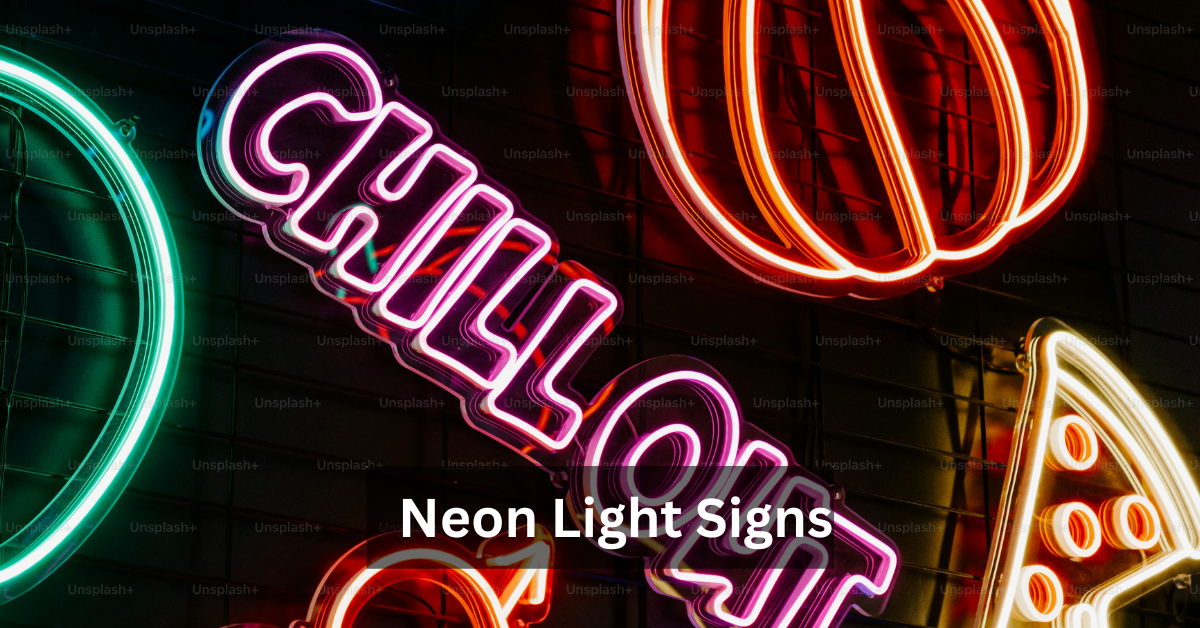LED neon signs are energy-efficient, durable, and flexible, making them a modern alternative to traditional glass neon.Whether you’re looking to add a touch of flair to your home decor or use neon signage for business branding, neon lights can bring life to any setting. This guide will explore everything you need to know about neon light signs, from their history and the science behind them to creative ideas and how to customize your own.
Neon light signs are iconic pieces of art that have the power to transform any environment. These glowing lights, typically crafted from neon or LED, are often associated with vibrant colors and an energetic aesthetic. Once used primarily for advertisements, neon signs have become a symbol of modernity and personalization in home and business decor. Their ability to infuse character into any space makes them a popular choice among designers, businesses, and homeowners alike.
As LED technology advances, modern neon signs, often referred to as LED Neon Signs, have become more energy-efficient, durable, and versatile. Whether it’s a motivational quote, a custom logo, or an intricate design, neon light signs are a captivating and exciting way to add ambiance and flair to any space.
The History and Evolution of Neon Light Signs
The Origin of Neon Lights
The story of neon signs dates back to the early 20th century. The first neon light was invented in 1898 by French engineer Georges Claude. Claude’s discovery of neon gas, which glows when electrified, led to the development of neon lights. In the 1920s, neon signs were introduced to the public, becoming a popular form of advertising in cities like New York and Paris. These early neon lights were created using glass tubes that were bent into various shapes and filled with neon gas.
The vibrant glow of neon signs quickly captured the public’s imagination, and they became a staple of urban landscapes, symbolizing the lively energy of the modern world.
How Neon Signs Evolved Over Time
Neon signage experienced its golden age during the mid-20th century, with businesses using these lights to grab attention and advertise products. However, the use of neon signs began to decline in the 1980s due to the rise of LED technology and concerns over the environmental impact of traditional neon. But in recent years, neon signs have made a comeback, thanks to advancements in LED neon flex and an increasing demand for personalized and creative decor.
Today, neon light signs are more versatile than ever, offering customizable options for both residential and commercial use. Companies like NeonPartys.com and CustomNeon.com provide customers with the ability to design their own neon signs, leading to a revival of this iconic form of lighting.
How Neon Light Signs Work: The Science Behind the Glow
The Process Behind Creating Neon Signs
Neon signs are created by filling glass tubes with a specific gas, such as neon, argon, or krypton. When electricity passes through the gas, it becomes ionized and emits light. The color of the light is determined by the type of gas used. For instance, neon gas emits a reddish-orange glow, while argon gas can produce blue or green lights. The glass tubes are bent into various shapes and sizes, forming words, logos, or intricate designs that become the iconic neon light signs we know today.
Differences Between Traditional Neon and LED Neon Signs
While traditional glass neon signs were popular for decades, they have a few limitations. For one, they are fragile and prone to breakage. Additionally, they consume more energy and require a transformer to operate. However, LED neon signs, such as LED Neon Flex, have become a popular alternative. LED neon lights mimic the look of traditional neon but are more durable, energy-efficient, and flexible. They can be bent into various shapes and designs, making them ideal for both intricate custom work and large-scale signage.
Types of Neon Light Signs: Exploring Your Options
Traditional Glass Neon Signs vs. LED Neon Signs
Traditional glass neon signs are made from bendable glass tubes filled with neon gas. These signs produce a bright, vibrant glow and have an iconic retro look that many people love. However, glass neon signs can be fragile, difficult to transport, and expensive to manufacture.
LED neon signs, on the other hand, are made using LED lights encased in flexible, durable plastic tubing. These signs offer the same glowing effect but are more energy-efficient, lightweight, and easier to handle. They also tend to last longer and are available in a wide range of colors.
Benefits and Limitations of Each Type
Both traditional glass neon signs and LED neon signs have their benefits and limitations. Glass neon signs have a classic, vintage appeal, which is why they are often used in high-end commercial spaces and specialty applications. On the other hand, LED neon signs are more versatile, affordable, and suitable for long-term use, making them an excellent choice for home decor, businesses, and events.
Why Choose Neon Light Signs?
Key Reasons for Selecting Neon Signs for Home Decor or Business Branding
Neon light signs are much more than just a light source—they are a statement. They help create ambiance, establish a mood, and add personality to any environment. For businesses, neon signs are an effective way to attract attention and establish brand identity. Personalized neon decor, such as custom logos or catchy phrases, can instantly create a memorable experience for customers.
For home decor, neon signs can be customized with inspirational quotes or decorative elements to brighten up living rooms, bedrooms, and offices. Whether it’s a cozy glow in a bedroom or an attention-grabbing piece in a retail store, neon signs add a unique touch to any space.
Aesthetic Appeal, Versatility, and Energy Efficiency
One of the main reasons for the growing popularity of neon signs is their aesthetic appeal. With a wide range of colors, shapes, and sizes available, neon signs can complement almost any style or theme. Whether you’re aiming for a vintage look or a modern vibe, neon lights have a way of fitting into any design scheme.
Furthermore, LED neon signs are an energy-efficient option, making them an eco-friendly alternative to traditional lighting. Unlike incandescent bulbs, LED neon lights consume less power and last longer, which means they are more cost-effective in the long run.
Creative Ideas for Using Neon Light Signs in Different Spaces
Home Decor: Living Rooms, Bedrooms, Home Offices
Neon signs are a great addition to any home. In the living room, they can serve as a fun and colorful centerpiece, while in the bedroom, they can add a cozy and personalized glow. Consider using motivational quotes, your favorite phrase, or abstract designs that resonate with you. For home offices, a neon sign can bring a creative flair and boost productivity.
Business Branding: Cafes, Bars, Retail Shops, and Event Spaces
For businesses, neon signage is a powerful marketing tool. A glowing neon logo or catchy tagline can attract customers and create a memorable experience. Cafes and bars, for instance, often use neon lights to establish a fun, lively atmosphere. Retail stores can showcase their logo or slogan, while event spaces can use custom neon signs to enhance the venue’s ambiance.
Special Events: Weddings, Birthdays, Parties, and More
Neon signs have become popular in event settings, offering a unique way to personalize a celebration. For weddings, custom neon signs with the couple’s names or wedding date make for great photo opportunities. Birthdays and other parties can feature neon messages or playful designs that reflect the theme of the event.
Customizing Your Own Neon Light Sign
Creating a custom neon light sign is easy and fun. Start by choosing a design or phrase that is meaningful to you. Then, select the colors, fonts, and shapes that best fit your space. Many online platforms, such as NeonPartys.com and CustomNeon.com, offer easy-to-use tools for designing personalized neon signs.
Some popular customization options include motivational neon quotes, custom business logos, and even artwork or symbols that hold personal significance.
How to Install Your Neon Light Sign
DIY Installation Tips
Installing a neon light sign is typically straightforward, especially with LED neon signs. Most LED neon signs come with easy-to-follow instructions for installation. You can hang your sign on the wall, place it on a shelf, or even mount it on the ceiling. For safety, always ensure that your sign is properly secured and that the power source is reliable.
Professional Installation vs. Self-Installation
While DIY installation is feasible for many people, some may prefer professional installation, especially for larger or more complex signs. Professional installers can ensure that your neon sign is mounted securely and that the wiring is safe. For smaller, simpler signs, self-installation is usually sufficient.
Safety Precautions to Consider
When installing your neon sign, always follow the manufacturer’s instructions. Ensure that the power supply is compatible with the sign’s requirements, and use the appropriate mounting tools. For glass neon signs, handle them with care to avoid breakage.
Maintaining and Caring for Your Neon Light Signs
Proper Cleaning Techniques
Neon signs require regular maintenance to keep them looking their best. To clean your neon sign, use a soft cloth and a mild soap solution. Avoid using abrasive materials, as they can damage the surface. For LED neon signs, simply wipe them down with a damp cloth to remove dust and dirt.
Troubleshooting Common Issues
If your neon sign stops working, the issue could be related to the power supply, wiring, or the sign itself. For LED neon signs, check the connections and ensure that the power supply is functioning. For glass neon signs, you may need to replace a tube or check the transformer.
Ensuring Longevity and Durability
To prolong the lifespan of your neon sign, avoid placing it in direct sunlight or in areas with extreme temperatures. For LED neon signs, ensure that the wiring is secure and avoid overloading the power source.
Where to Buy Neon Light Signs: Top Providers
There are many trusted platforms where you can buy neon light signs, including NeonPartys.com and CustomNeon.com. These sites offer a range of customizable options, from personal quotes to intricate designs. Etsy and Amazon also feature a variety of neon signs, from handmade pieces to mass-produced options.
When purchasing a neon sign, be sure to check the materials used, the quality of craftsmanship, and the reputation of the seller. Opt for well-known manufacturers or suppliers to ensure durability and quality.
The Future of Neon Light Signs
Trends in Neon Sign Technology
As technology advances, so does the design and production of neon light signs. LED Neon Flex, for instance, is a modern alternative to traditional neon, offering flexibility, energy efficiency, and durability. The future of neon signs will likely see even more innovative designs and eco-friendly options.
How Neon Signs Are Adapting to Modern Design Preferences
Neon signs are becoming increasingly popular in minimalist and contemporary design schemes. With customizable shapes and colors, neon signs can complement modern decor trends, making them a timeless addition to both residential and commercial spaces.
Why Choose NeonPartys.com for Your Custom Neon Light Signs
When it comes to creating a custom neon light sign, https://neonpartys.com/ is the go-to destination for high-quality, personalized designs. Offering a user-friendly platform, Neon Party allows you to bring your creative vision to life by customizing your neon sign with a wide range of colors, fonts, and sizes. Whether you’re decorating your home, branding your business, or planning an event, https://neonpartys.com/ ensures that you receive a durable, energy-efficient LED neon sign that perfectly suits your needs. With fast, reliable shipping and excellent customer service, NeonPartys.com makes it easy to add a personalized glow to any space, making it the perfect choice for anyone looking for a unique and vibrant lighting solution.
Conclusion
Neon light signs are more than just functional—they are artistic pieces that can elevate any space. From home decor to business branding, neon signs offer endless possibilities for creativity and personalization. Whether you’re looking to add a glow to your living room, attract customers to your shop, or celebrate a special occasion, neon light signs are a powerful tool for transformation.
With their vibrant colors, energy efficiency, and endless customization options, neon light signs are an investment that will continue to shine bright for years to come.
Frequently Asked Questions
Can I customize my neon sign?
Yes, many platforms, like NeonPartys.com, offer customization options for colors, fonts, and designs.
How long do neon light signs last?
LED neon signs can last up to 50,000 hours, while traditional glass neon signs have a shorter lifespan.
Are neon signs safe to use?
Yes, neon signs are safe to use when installed and maintained correctly. However, for glass neon signs, it’s important to handle them carefully to avoid breakage. Always follow the manufacturer’s installation and safety guidelines, especially when dealing with electrical connections.
How can I clean my neon light sign?
To clean a neon light sign, use a soft cloth and a mild soap solution. For LED neon signs, simply wipe down the surface with a damp cloth to remove dust. Avoid using abrasive cleaners to prevent damage.
Can neon signs be used outdoors?
Yes, there are outdoor-friendly neon signs designed to withstand the elements. These signs are made with weather-resistant materials, so they can be safely placed in outdoor settings like patios, gardens, or business storefronts.
What is the cost of a custom neon sign?
The cost of a custom neon sign can vary depending on the size, design complexity, and material used. On average, small to medium-sized custom neon signs range from $100 to $500. Larger, more intricate designs may cost more.
Stay in touch to get more updates & alerts on Erome! Thank y



